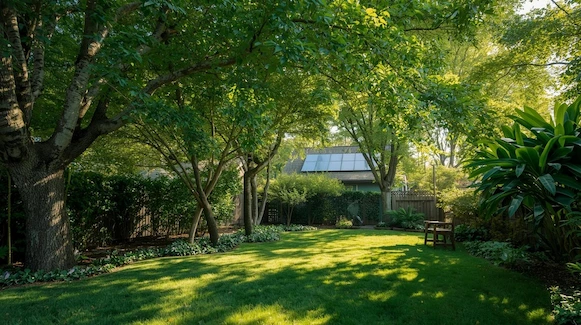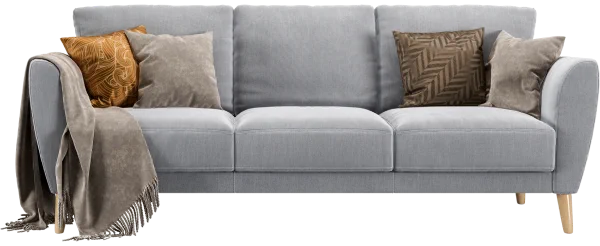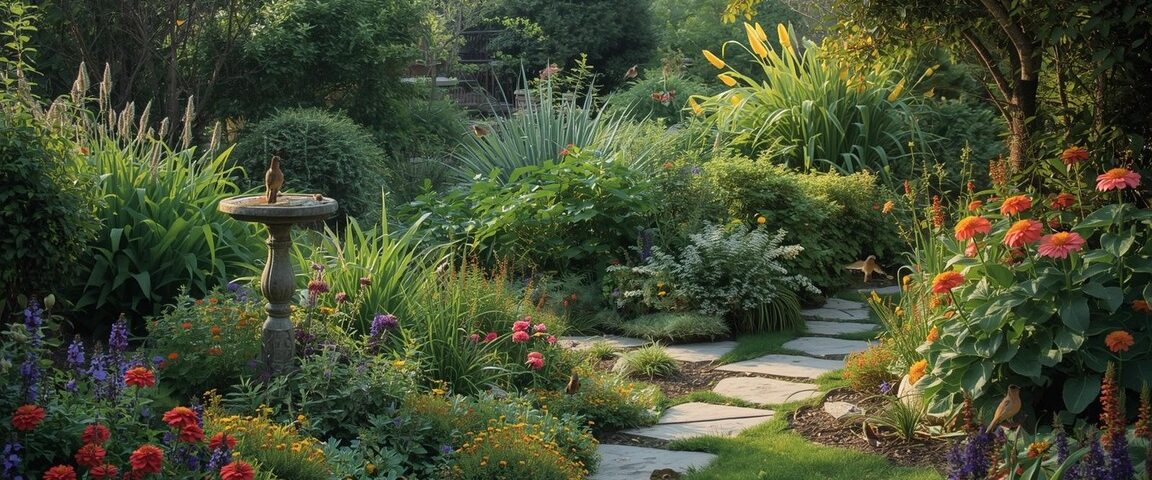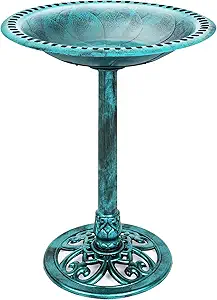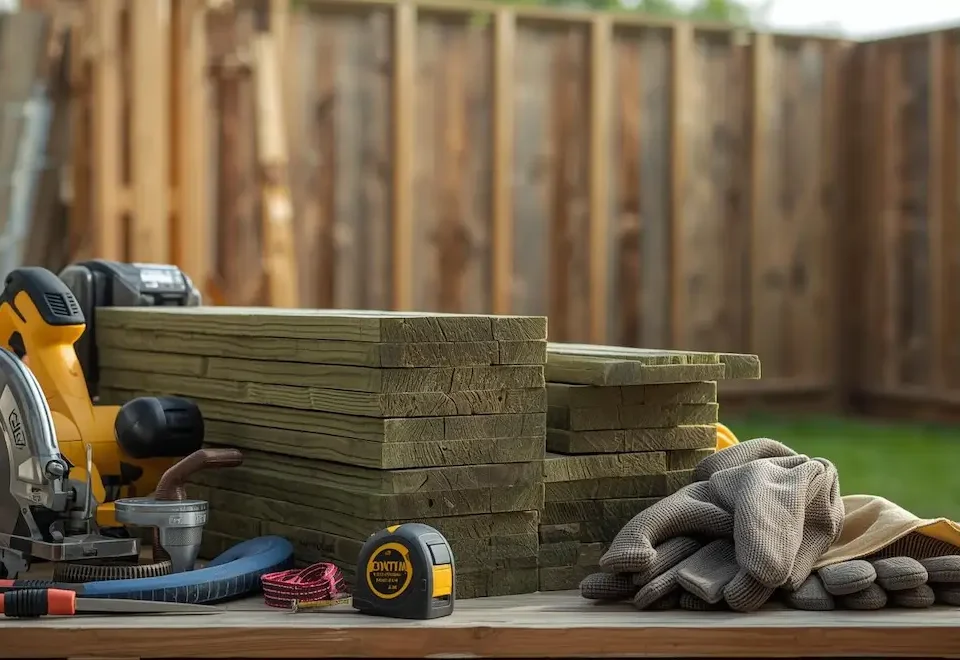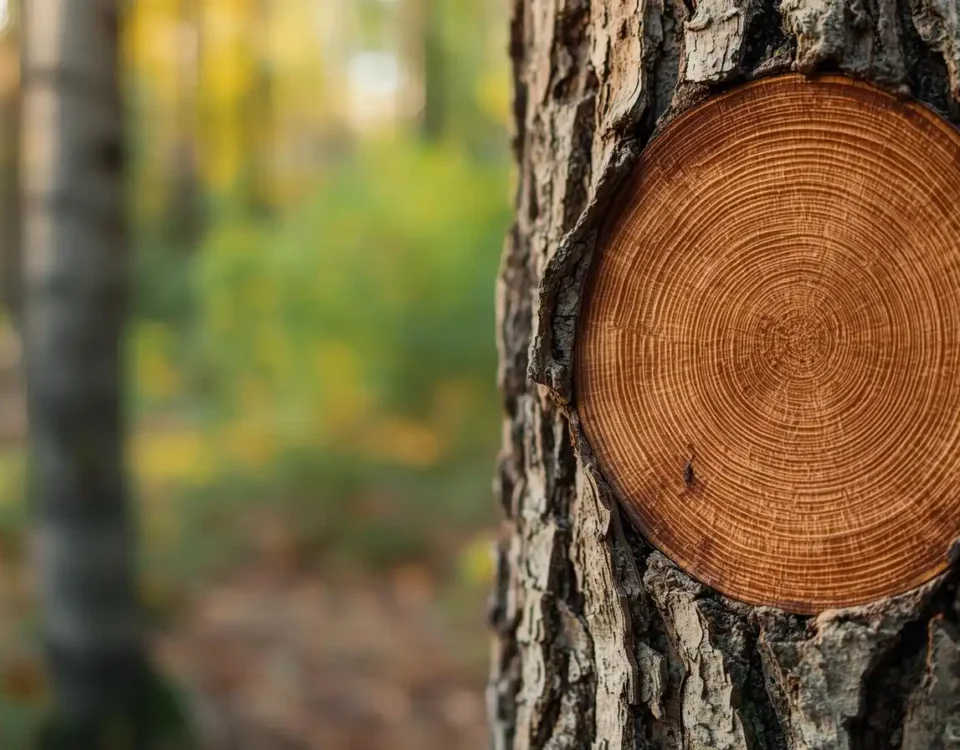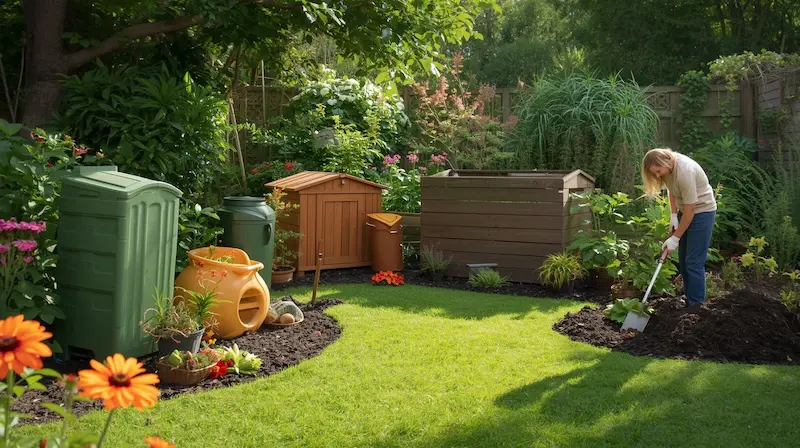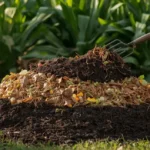
Compost Confessions Master the Top 10 Mistakes for Perfect Soil Every Time
October 25, 2025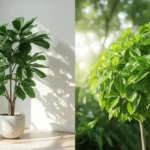
Ficus Tree Mastery The Comprehensive Guide to Thriving Indoor & Outdoor Ficus
October 25, 2025The Call of the Wild: Bringing Nature to Your Backyard
Imagine stepping into your backyard, not just to a quiet stretch of grass, but into a space alive with sound and movement, the cheerful chorus of native birds, the flutter of wings, and the gentle rustle of leaves alive with hidden activity. Many people dream of this kind of living garden, a small sanctuary where nature feels close enough to touch, as explored on Homes and Looms. But too often, that dream doesn’t quite take shape. Lawns stay silent, bird feeders go unused, and gardens feel more decorative than alive.
Maybe you’ve hung feeders only to see a few fleeting visitors, or you’ve browsed endless plant lists, unsure which species actually make a difference. It’s easy to feel lost when your goal is to create a haven for wildlife, but you’re unsure where to begin. That’s where this guide comes in. It bridges that gap between wanting a beautiful, thriving garden and knowing exactly how to build one that truly supports local birds and biodiversity.
Here, you’ll learn how to go beyond surface-level beauty and design a garden that functions as a living ecosystem. Through the smart use of native plants and planning, you can attract a wide range of bird species and keep them coming back all year. This isn’t just about creating an attractive space; it’s about restoring balance, welcoming life, and contributing to the natural world right outside your door. By the end, you’ll be ready to transform your backyard into a vibrant, sustainable bird sanctuary, one that hums with energy, color, and life every single day.
Understanding Bird Needs: The Four Pillars of Habitat
Creating a bird-friendly backyard starts with understanding what birds actually need to live, not just visit. Every successful habitat, no matter its size, provides four key elements: food, water, shelter, and nesting sites. When these components work together, they form a balanced ecosystem that supports birds throughout the year.
Food: Fueling the Feathered Visitors
Food is the cornerstone of any wildlife habitat. Birds, like all creatures, are drawn to places that can reliably sustain them. The best approach is to build your food web from the ground up, starting with native plants.
Natural Food Sources
Native plants are nature’s perfect pantry. They produce the berries, seeds, and nuts that local birds have evolved to depend on. For instance, berry-producing shrubs like serviceberry, dogwood, and viburnum can attract robins, thrushes, and waxwings. Seed-bearing flowers such as coneflowers and sunflowers are favorites of finches and sparrows.
Equally important are the insects these plants support. Caterpillars, beetles, and spiders provide the high-protein meals that adult birds need to feed their young. Native oaks, willows, and goldenrods host hundreds of insect species, which in turn keep the avian population thriving. Nectar-rich native flowers, like bee balm, columbine, and penstemon, also play a vital role, sustaining hummingbirds and other nectar-feeders.
Supplemental Feeding (with Caveats)
Feeders can be helpful, especially in winter or urban areas where natural food is scarce, but they should supplement rather than replace native food sources. Black-oil sunflower seeds attract a wide variety of birds, nyjer seeds draw finches, and suet supports woodpeckers and nuthatches.
The key is responsibility. Dirty feeders can spread disease quickly. Clean them at least once a week with a mild bleach solution and make sure uneaten food doesn’t pile up. Rotate feeding spots periodically to prevent the buildup of waste and bacteria.
E-E-A-T Consideration
Native plants remain the most valuable and sustainable food source. They create a self-sufficient system where plants support insects, insects support birds, and birds help control pests and spread seeds. It’s a symbiotic cycle that keeps your backyard ecosystem balanced, and it’s far healthier for wildlife than relying solely on store-bought seed.
Water: The Essential Refreshment
Water is often overlooked, but it’s just as critical as food. Birds need it for drinking, bathing, and maintaining their feathers. A reliable water source can make your garden a daily destination.
Why Water Matters
Bathing isn’t just for cleanliness. When birds bathe, they remove dust and parasites, keeping their feathers in prime condition for insulation and flight. Preening afterward helps them realign feather barbs, an important process for staying waterproof and agile.
Types of Water Features
You don’t need a pond or elaborate fountain to make a difference. A simple, shallow bird bath is often enough. Add a few stones for perching and ensure the edges have a gradual slope so smaller birds feel safe. Moving water, such as a dripper, mister, or small fountain, can be even more effective, as the sound attracts birds from a distance.
Safety and Maintenance
Keep water features clean and fresh. Replace the water every few days to prevent mosquito breeding and scrub away algae buildup. The ideal depth for a bird bath is about two inches in the center and shallower near the edges. Rough surfaces help birds grip and feel secure.
Shelter: A Safe Haven
A truly bird-friendly yard offers more than food and water; it provides refuge. Shelter protects birds from predators, harsh weather, and even human disturbance.
Protection from Predators
Dense shrubs and thorny plants such as hawthorn or holly provide excellent hiding spots. Birds instinctively seek cover where they can quickly disappear from view. Layer your garden with a mix of low shrubs, mid-level plants, and taller trees to create multiple safe zones.
Shelter from the Elements
Evergreens like spruce and juniper offer year-round protection from wind, rain, and snow. In summer, thick foliage gives birds cool, shaded retreats, especially with fast-growing trees for cooling. Positioning these plants strategically can make your yard a dependable shelter during extreme weather.
Roosting Sites
At night, many birds need secure perches to rest. Tree cavities, tangled vines, and even brush piles provide excellent roosting spots. By leaving some natural debris, like fallen branches or leaf piles, you create a more authentic, protective environment.
Nesting Sites: Raising the Next Generation
A bird’s choice to stay in your yard long-term often depends on whether it’s suitable for raising young. Creating safe nesting options encourages breeding pairs to settle in and return year after year.
Appropriate Plant Structures
Dense shrubs, sturdy branches, and thick foliage give birds natural nesting options. Species such as robins prefer open branches, while wrens and sparrows look for hidden thickets. When pruning, leave some areas slightly untamed; those natural spots often become prime nesting sites, avoiding common tree pruning mistakes.
Nesting Materials
Nature provides most of what birds need: twigs, leaves, grass, moss, and even spider silk. These materials are vital for building nests that are soft, stable, and well-camouflaged. By maintaining plant diversity, you automatically supply a variety of nesting resources.
Birdhouses (Species-Specific)
Well-designed birdhouses can help species that rely on cavities, such as bluebirds, chickadees, or nuthatches. Each species has different preferences for hole size, height, and location, so it’s best to research before installing. Place birdhouses away from heavy traffic and direct sunlight, and clean them between breeding seasons to keep them safe and inviting.
The Power of Native Plants: Trees & Shrubs for Birds
Native plants form the foundation of any truly bird-friendly landscape. They aren’t just decorative, they’re functional, resilient, and deeply connected to the environment around them. These plants have evolved over thousands of years to thrive in your region’s soil, weather, and seasonal patterns. More importantly, they’ve developed intricate relationships with local insects and wildlife, making them irreplaceable in a healthy ecosystem. When you fill your yard with native trees and shrubs, you’re not just planting greenery; you’re rebuilding nature’s food web.
Why Native Plants Are Superior
Ecological Match
Native plants are the natural partners of local birds. Their berries ripen at the right time of year, their seeds are the right size, and their flowers produce the nectar that specific pollinators depend on. These plants offer exactly what local bird species have evolved to eat and use. For example, a native dogwood provides both insects for warblers and bright red berries that sustain thrushes and cardinals. In contrast, many imported or ornamental plants may look beautiful but provide little or no nutrition to native wildlife.
Insect Support
Birds rely heavily on insects, especially during breeding season. Insects are high in protein and essential for feeding hatchlings. Native plants host native insects, everything from caterpillars and beetles to spiders and bees. A single chickadee family, for instance, can consume thousands of caterpillars before the young leave the nest. Without native plants to support those insects, that critical food supply disappears. Non-native ornamentals simply don’t offer the same abundance or variety of insect life.
Low Maintenance
Another major advantage of native plants is their resilience. Because they’re adapted to local conditions, they typically need less water, fertilizer, and pest control than exotic species. Once established, they can handle droughts, local pests, and changing seasons with minimal intervention. This makes them not only good for birds but also for you, a healthier, lower-maintenance garden that thrives naturally, especially with quality gardening gloves.
Expert Tip: Always choose native species over exotics. While exotic plants might seem appealing for their unusual colors or shapes, they often provide little ecological value. Native plants, on the other hand, support the specific insects, shelter, and nesting materials that local birds have evolved alongside.
Beyond Beauty: The Bigger Ecological Picture
A landscape rich in native plants does far more than attract birds. It strengthens the entire local ecosystem, creating a chain of benefits that ripple outward.
Natural Pest Control
By attracting insect-eating birds like chickadees, nuthatches, and warblers, native gardens help keep pest populations in check. Instead of relying on pesticides, you allow the ecosystem to balance itself, perhaps with a helpful patio weeder.More insects may seem like a drawback at first, but in reality, they’re the backbone of the food chain. The more diverse your insect population, the healthier your environment becomes.
Soil Health and Water Retention
Native trees and shrubs typically have deep, well-developed root systems that improve soil structure and prevent erosion. These roots help water soak into the ground rather than running off, reducing flooding and recharging groundwater. Over time, this natural cycle keeps your soil richer and your plants healthier without chemical intervention.
Biodiversity Boost
A garden filled with native plants becomes a small-scale wildlife refuge. Butterflies, bees, and other pollinators thrive alongside birds, creating a dynamic and balanced ecosystem. This biodiversity strengthens local resilience; when one species struggles, others step in to maintain balance. Your yard becomes a vital link in the chain of life that stretches through your neighborhood and beyond.
Examples of Bird-Friendly Native Trees and Shrubs
While the best species vary by region, many native trees and shrubs consistently support birds across different environments. Here are some standouts:
- Oaks (Quercus species): Host hundreds of caterpillar species, making them top food sources for insect-eating birds.
- Serviceberry (Amelanchier): Offers early spring flowers for pollinators and summer berries for robins and cedar waxwings.
- Eastern Red Cedar (Juniperus virginiana): Provides berries in winter and dense cover for nesting and roosting.
- Elderberry (Sambucus): Produces clusters of fruit that attract thrushes, catbirds, and orioles.
- Dogwood (Cornus): Valued for both insect support and its late-summer berries.
- Viburnum (Viburnum species): Offers nectar in spring, berries in fall, and dense foliage for nesting.
- Willow (Salix): Supports a wide range of insects, making it excellent for food diversity.
Planting a mix of these species ensures your yard provides nourishment and shelter year-round, flowers and insects in spring, fruits in summer and fall, and evergreen protection in winter.
Building a Resilient Backyard Ecosystem
When you design your garden around native plants, you’re doing more than creating a haven for birds; you’re restoring balance to your environment. Every native tree or shrub you plant helps rebuild the natural systems that once existed before urban development fragmented them. The result is a landscape that’s both beautiful and beneficial, where the sights and sounds of nature return to stay.
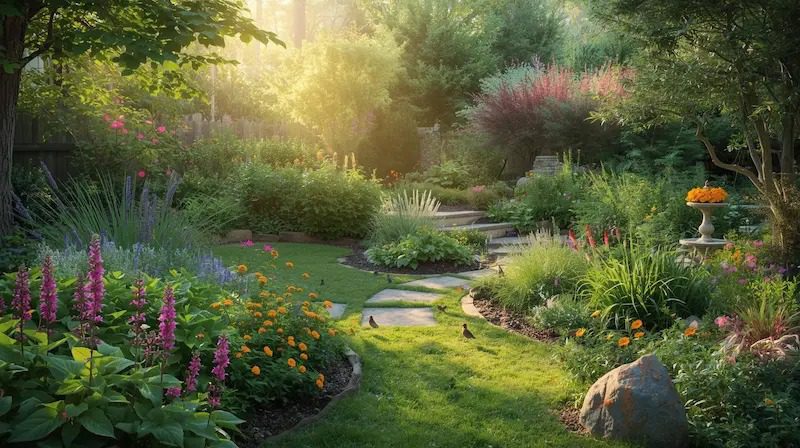
Top Native Trees for Bird Attraction (Regional Examples)
Native trees form the backbone of any bird-friendly landscape. As the tallest layer of vegetation, they provide food, shelter, and nesting sites that support a wide variety of species. From the acorns of mighty oaks to the berries of serviceberries and dogwoods, these trees sustain bird populations throughout the seasons. Because native trees vary by region, it’s important to choose species that naturally occur in your local ecosystem.
(Note: The examples below represent commonly beneficial native trees found across much of North America. Always verify what’s native to your specific region using trusted resources such as the Audubon Native Plants Database or the National Wildlife Federation’s Native Plant Finder.)
|
Native Tree Species |
Bird Benefits (Food, Shelter, Nesting) |
Key Features (Fruit Type, Bloom Time) |
Ideal Growing Conditions (Sun, Soil, Zone) |
|
Serviceberry (Amelanchier spp.) |
Produces early-summer berries; supports nesting and insect life |
Edible purple-red berries, white spring flowers, brilliant fall color |
Full sun to partial shade; well-drained soil; Zones 3–9 |
|
Oak (Quercus spp.) |
Acorns for food; hosts hundreds of insect species; excellent nesting cover |
Dense canopy, lobed leaves, hard acorns |
Full sun; adaptable to most soils; Zones 3–9 |
|
Eastern Redcedar (Juniperus virginiana) |
Blueberries for winter food; evergreen shelter and nesting |
Scale-like foliage, conical form, persistent berries |
Full sun; tolerates poor or dry soil; Zones 2–9 |
|
Flowering Dogwood (Cornus florida) |
Red berries in fall; attracts songbirds; supports pollinators |
Showy white spring bracts, red fall berries, and an elegant shape |
Partial shade; moist, acidic, well-drained soil; Zones 5–9 |
|
Black Cherry (Prunus serotina) |
Small dark cherries in summer; hosts caterpillars and other insects |
White flower clusters, dark bark, colorful autumn foliage |
Full sun to partial shade; adaptable to varied soils; Zones 3–9 |
Expanding the List: Additional Bird-Friendly Trees
If your goal is to build a richly layered habitat, consider adding a mix of deciduous and evergreen species. Here are a few more native options commonly recommended across regions:
- American Holly (Ilex opaca): Evergreen foliage with red winter berries that attract thrushes and cedar waxwings; thrives in partial shade and well-drained soil (Zones 5–9).
- Maple (Acer spp.): Supports sap-feeding insects that attract woodpeckers and warblers; provides dense canopy cover. Best in full sun to partial shade, moist soil (Zones 3–8).
- Birch (Betula spp.): Seeds feed finches and siskins; bark supports insect larvae. Prefers full sun and moist, well-drained soil (Zones 2–7).
- Pine (Pinus spp.): Evergreen needles provide year-round shelter; cones produce seeds for crossbills and nuthatches. Grows in sandy or well-drained soils (Zones 2–8).
Designing for Diversity: Expert Tips
Think in Layers
Birds use different layers of vegetation for different purposes. Tall canopy trees provide nesting and lookout perches, understory trees offer food and shelter, shrubs give cover, and groundcovers attract insects. Aim for variety in height and structure; this layered design creates microhabitats that appeal to a wider range of bird species.
Plant in Groups
Birds are more likely to visit areas where resources are abundant and visible. Grouping several of the same species, such as a cluster of berry-producing dogwoods or serviceberries, creates a stronger visual cue and a more reliable food source. Group plantings also mimic natural patterns, making the space feel safer and more familiar to wildlife.
Combine Trees with Complementary Plants
Underplant trees with compatible shrubs and native perennials to create a seamless ecosystem. For instance, beneath an oak, plant native grasses and wildflowers that attract insects, or pair serviceberries with viburnums and elderberries to extend your berry season into fall.
The Broader Impact
Native trees do far more than attract birds. Their deep roots stabilize soil, filter rainwater, and store carbon, all part of essential tree bark care. Their leaves and flowers support pollinators and beneficial insects, which in turn feed the birds, often benefiting from mastering tree shapes.By planting native trees, you’re doing more than decorating your yard; you’re restoring a small but vital piece of the natural world, often with a reliable garden tools set.
A thoughtfully designed canopy of native trees transforms your outdoor space into a self-sustaining bird sanctuary. Whether you have a sprawling yard or a modest plot, even one or two well-chosen native trees can make a measurable difference for local wildlife.
Essential Native Shrubs for Bird Attraction (Regional Examples)
Shrubs are the heart of the mid-layer in a bird-friendly garden. They provide dense cover for protection, essential nesting sites, and a steady supply of berries, insects, and flowers throughout the seasons. Native shrubs, in particular, are invaluable because they evolved alongside local wildlife, offering exactly what native birds need. These plants also help prevent soil erosion, improve water retention, and add visual depth to the landscape, making them both beautiful and functional.
(Note: The examples below are verified through reputable sources, including university extension programs such as Penn State Extension, University of Maryland Extension, University of New Hampshire Extension, and West Virginia University Extension. Always confirm which species are native to your specific area using tools like the Audubon Native Plants Database or the National Wildlife Federation’s Native Plant Finder.)
|
Native Shrub Species |
Bird Benefits (Food, Shelter, Nesting) |
Key Features (Berry Color, Height) |
Ideal Growing Conditions (Sun, Soil, Zone) |
|
American Elderberry (Sambucus canadensis) |
Produces late-summer berries relished by over 40 bird species (WVU Extension); hosts insects for foraging |
Large flat-topped white flower clusters; fast-growing; 5–12 ft tall |
Full sun to partial shade; moist, rich soil; Zones 3–9 |
|
Red Osier Dogwood (Cornus sericea) |
White berries in fall; dense thickets provide shelter for nesting songbirds (USDA Plant Guide) |
Bright red stems for winter interest; white flowers; 6–10 ft tall |
Full sun to partial shade; prefers moist to wet soils; Zones 2–8 |
|
Viburnum (Viburnum spp.) |
Red or blue berries that feed birds through fall and winter (UNH Extension); excellent nesting and cover |
Fragrant white flowers; dense foliage; species range from 4–15 ft |
Full sun to partial shade; moist, well-drained soil; Zones 2–9 |
|
Inkberry Holly (Ilex glabra) |
Evergreen foliage for year-round shelter; black berries that feed thrushes and waxwings (UMD Extension) |
Compact evergreen with small leaves; subtle flowers; 5–8 ft tall |
Full sun to partial shade; acidic, moist soil; Zones 4–9 |
|
Nannyberry Viburnum (Viburnum lentago) |
Blue-black berries persist into winter; dense structure ideal for nesting (Forest Preserves of Cook County) |
Creamy white flower clusters; reddish fall color; can grow to 15–30 ft |
Full sun to partial shade; adaptable to varied soils; Zones 2–8 |
Why Shrubs Matter in Bird Habitat Design
Native shrubs fill a vital ecological niche between groundcovers and trees. They offer birds protection from predators, access to food close to the ground, and places to rest or nest out of direct exposure. Because many species flower, fruit, or hold berries at different times, combining several types of shrubs ensures food availability across seasons.
For instance, elderberries provide summer fruit, dogwoods and viburnums fruit in fall, and hollies carry their berries through the winter, creating a year-round buffet that keeps birds coming back.
Design Tips for Using Shrubs Effectively
- Think in Layers
A layered habitat attracts the greatest variety of birds. Combine tall canopy trees, understory trees, native shrubs, perennials, and groundcovers. This structure mimics natural woodlands and provides spaces for species with different feeding and nesting habits. - Plant in Groups
Birds are more likely to visit when plants are clustered. Grouping several of the same shrub species, like a trio of viburnums or a hedgerow of red osier dogwoods, creates a more noticeable food source and increases the sense of safety. Groupings also produce a denser, more natural look. - Mix Evergreen and Deciduous Shrubs
Evergreens like inkberry holly provide year-round shelter, while deciduous species like elderberry and dogwood add seasonal color and fruit. Mixing both types balances visual appeal and ecological function. - Prioritize Diversity and Timing
Choose shrubs that bloom and fruit at different times to keep your garden active year-round, starting with spring garden preparation. Spring blossoms attract pollinators and insects, summer berries nourish fledglings, and winter fruits sustain migrating or overwintering species.
E-E-A-T Consideration: Building Authority Through Ecology
According to the University of New Hampshire Extension and the Audubon Society, native shrubs play a key role in local ecosystems by:
- Supporting native insects, which provide the protein-rich diet many birds need to raise young.
- Improving soil structure and moisture retention with deep, fibrous roots.
- Enhancing biodiversity, reducing reliance on pesticides, and stabilizing local habitats.
When you plant native shrubs, you’re not just making your yard more attractive; you’re helping repair the ecological web that sustains both wildlife and people.
Designing Your Bird-Friendly Landscape: Layout & Placement
Creating a bird-friendly garden isn’t just about choosing native plants; it’s about how you arrange them. The goal is to design a balanced, layered habitat that provides food, water, and shelter while also offering a safe and visually pleasing environment. When you think of your yard as a miniature ecosystem, every tree, shrub, and patch of flowers plays a role in supporting birds and other wildlife.
A thoughtful layout uses structure and diversity to mimic nature. Birds thrive when they can move vertically and horizontally through layers, feeding in one, nesting in another, and resting in between. Strategic placement also protects them from predators and collisions while inviting you to enjoy the beauty of their activity up close.
|
Landscape Zone |
Purpose for Birds |
Recommended Plants/Features |
|
Canopy Layer |
Provides the tallest structure for nesting, roosting, and predator protection. Serves as a lookout point for many species. |
Large native trees such as Oaks (Quercus spp.), Maples (Acer spp.), American Elm (Ulmus americana), Pines (Pinus spp.), or Tulip Tree (Liriodendron tulipifera). In the western U.S., consider Douglas Fir (Pseudotsuga menziesii) or Cottonwood (Populus spp.). These trees host insects, provide acorns or seeds, and create critical canopy cover. |
|
Understory Layer |
Smaller trees and large shrubs that bridge the gap between canopy and ground layers, providing mid-level nesting and foraging sites. |
Serviceberry (Amelanchier spp.), Flowering Dogwood (Cornus florida), Hawthorn (Crataegus spp.), Eastern Redbud (Cercis canadensis), and Crabapple (Malus spp.). These species offer spring blooms for pollinators and berries for birds in summer and fall. |
|
Shrub Layer |
Dense cover for hiding, nesting, and protection from ground predators. Produces berries and supports insects. |
Viburnums (Viburnum spp.), Elderberry (Sambucus canadensis), Winterberry (Ilex verticillata), Red Osier Dogwood (Cornus sericea), and Chokeberry (Aronia melanocarpa). Plant in clusters for better visual cues and more abundant foraging. |
|
Perennial & Groundcover Layer |
Provides insects, seeds, nectar, and low-level foraging habitat. Also supports ground-nesting species and pollinators. |
Native wildflowers like Coneflower (Echinacea spp.), Aster (Symphyotrichum spp.), Black-eyed Susan (Rudbeckia hirta), and Goldenrod (Solidago spp.). Pair with native grasses such as Little Bluestem (Schizachyrium scoparium) or Switchgrass (Panicum virgatum) for texture and seed sources. Add ferns or creeping groundcovers like Wild Ginger (Asarum canadense) for shady areas. |
|
Edges & Transitional Zones |
Dynamic spaces where habitats overlap, highly attractive to birds for feeding and movement. |
Mix shrubs, tall perennials, and small trees to create gradual transitions. For example, blend Dogwoods and Serviceberries with Goldenrod or Joe-Pye Weed (Eutrochium spp.) for structure and nectar variety. These edge habitats mimic forest borders where biodiversity thrives. |
|
Water Feature Zone |
Essential for drinking and bathing, which help birds maintain healthy feathers. |
Bird baths, shallow ponds, misters, or drippers. Keep water fresh and shallow (no more than two inches deep). Add stones or branches for perching. A small recirculating pump can create movement that attracts birds. |
|
Safety Zone |
Protects birds from hazards such as predators and window collisions while allowing easy access to food and water. |
Place feeders and baths near dense cover, ideally within 10–15 feet of shrubs or trees, so birds can quickly retreat to safety. Avoid placing them directly in open lawns or too close to reflective windows. Use window decals or screens to prevent collisions. |
Design Principles for a Functional and Beautiful Bird Habitat
- Think in Layers and Patterns
Nature rarely grows in straight lines. To mimic natural habitats, plant in layers and clusters rather than rows. Each layer, from tall canopy trees to low perennials, supports different species. Tall trees give birds vantage points, mid-sized trees and shrubs offer nesting cover, and the ground layer provides insects and seeds. This structure not only helps wildlife but also makes your landscape more visually dynamic.
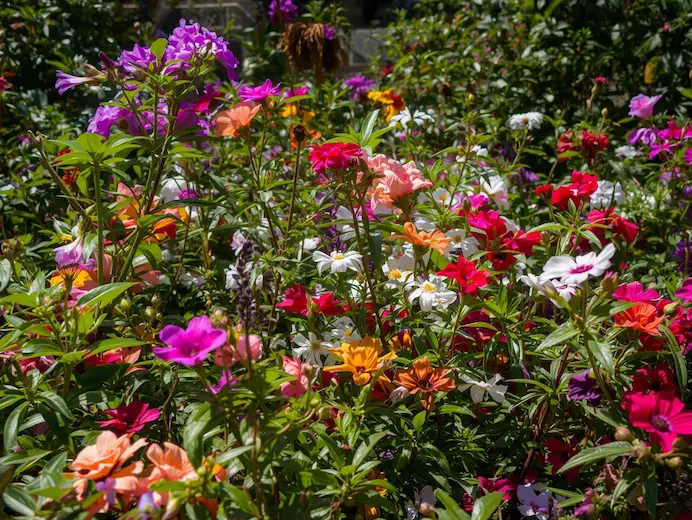
- Balance Open and Covered Spaces
Birds need both open areas for flight and dense vegetation for safety. Create a mix of meadow-like clearings and protected thickets. Open spots encourage foraging, while clustered shrubs and trees provide essential shelter. - Plan for Year-Round Interest
Select plants that offer resources in every season. Early-flowering trees like redbud attract spring insects. Summer berry producers, such as serviceberry, feed nesting birds. Fall-fruiting viburnums and winterberries keep migratory and overwintering species nourished through the cold months. - Keep Safety in Mind
Situate bird feeders, baths, and nesting boxes away from heavy foot traffic and predators. Cats are one of the leading threats to backyard birds, so avoid placing features too close to ground-level hiding spots. At the same time, ensure birds can find quick cover within a short flight distance. - Incorporate Native Diversity
While a single oak or dogwood can make a big impact, diversity strengthens your habitat. Include a mix of species that fruit or bloom at different times and thrive in varied light and soil conditions. This ensures a continuous supply of food and shelter, even when some plants are dormant. - Include Natural Materials
Use mulch made from shredded leaves, wood chips, or pine needles instead of synthetic alternatives. Leave some leaf litter and fallen branches; these create microhabitats for insects, which in turn feed the birds.
Expert Tips
- Plant in Groups: Birds are more likely to notice plants that occur in clusters rather than isolated individuals. For instance, three elderberries will attract more activity than one.
- Position Feeders Wisely: Keep feeders near protective shrubs but away from areas where cats or other predators can hide.
- Use Native Landscaping Resources: Tools like the Audubon Native Plants Database can suggest species specific to your zip code, helping you design regionally appropriate layers.
Layering for Diverse Habitats
One of the most effective ways to attract and support birds is by recreating the natural structure of wild habitats. In forests, meadows, and wetlands, vegetation grows in distinct vertical layers, from the tall canopy down to low-growing groundcovers. Each layer provides food, nesting sites, and protection for different species.
When you design your landscape with this in mind, you’re not just planting a garden; you’re building an ecosystem, perhaps even a unique hugelkultur garden bed.
Mimicking Natural Ecosystems
A layered landscape mimics how nature operates:
- Canopy layer: Tall trees like oaks, maples, and pines offer nesting sites for larger birds and protection from predators.
- Understory layer: Smaller trees such as dogwoods and serviceberries provide mid-level nesting and foraging areas.
- Shrub layer: Dense shrubs like viburnums and hollies offer cover and berries.
- Herbaceous layer: Wildflowers and grasses attract insects, nectar feeders, and seed eaters.
- Groundcover layer: Ferns, creeping plants, and leaf litter create foraging grounds for sparrows and other ground dwellers.
Benefits of Layering
Each layer contributes to a rich bird habitat:
- Varied foraging heights: Different bird species feed at different levels, warblers in treetops, wrens in shrubs, and sparrows on the ground.
- Diverse nesting options: Some birds prefer cavities in trees, others nest in shrubs, while a few build their homes on the ground.
- Safe escape routes: Multiple layers provide quick cover when predators are near.
- Seasonal interest: A mix of layers ensures food and shelter are available year-round.
Expert Tip: Think in layers. Combine tall trees, understory trees, shrubs, perennials, and groundcovers to create diverse vertical habitat zones that appeal to a wide range of bird species.
Strategic Placement for Safety & Visibility
Even the most diverse garden can fall short if birds don’t feel safe. Strategic placement of plants and features ensures both comfort and protection.
Predator Awareness:
Place dense shrubs or evergreens close to feeding areas and bird baths, within about 10 to 15 feet. This gives birds a quick escape route while keeping them visible to you.
Preventing Window Collisions:
- Keep feeders and baths very close (within 3 feet) or far away (over 30 feet) from windows. Birds flying from nearby perches won’t build up dangerous speed.
- Apply window decals, netting, or screens to break up reflections and prevent accidents.
Edge Effects:
Birds thrive in transitional spaces where different habitats meet, like the edge of a wooded area bordering an open lawn. These “edges” support high biodiversity. Create them intentionally by blending tall trees, shrubs, and perennials rather than planting in uniform blocks.
Differentiation Tip:
Think of water, shelter, and food as interconnected. Place bird baths or shallow ponds near clusters of berry-producing shrubs for quick access to both food and hydration. Add brush piles or evergreen cover nearby for immediate shelter. This layering of functions mimics how birds use natural habitats efficiently and safely.
Converting Lawn to Lush: A Phased Approach
Transforming a traditional lawn into a bird haven doesn’t have to happen overnight. By breaking it into manageable steps, you can create a thriving habitat over time without straining your budget.
Expert Tip: Lawns provide almost no value for birds or beneficial insects. Even replacing small portions with native plantings can make a big difference.
Phase 1: Observation & Planning
Spend time watching how sunlight moves across your yard. Identify areas with full sun, partial shade, or damp soil. Take note of where birds already visit; these are good starting points for conversion.
Phase 2: Initial Plantings
Begin with foundation species, a few native trees or large shrubs that define structure. Good starters include serviceberry, red maple, oak, or viburnum. These plants create the backbone for future layering.
Phase 3: Expanding & Layering
Add shrubs, perennials, and groundcovers beneath your initial trees. Use native grasses and flowering perennials like coneflower, black-eyed Susan, and bluestem grass for variety.
Phase 4: Adding Features
Introduce bird baths, misters, or small ponds for water. Add brush piles made of trimmed branches or leaves in out-of-sight corners for natural shelter.
Budget-Friendly Tips
- Start small and expand each season.
- Propagate from cuttings or seeds.
- Visit local native plant sales or conservation district giveaways.
- Trade plants with neighbors to increase diversity at little cost.
Over time, your once-monotone lawn will evolve into a vibrant, layered ecosystem full of color, sound, and life.
Beyond Plants: Enhancing Your Bird Habitat
While native vegetation forms the foundation, other elements can elevate your yard into a complete sanctuary.
Water Features: Attracting with Hydration
Birds are drawn to moving, clean, and shallow water sources. Whether it’s a simple dish or a small pond, water invites constant activity.
|
Bird Bath Type |
Pros |
Cons |
Maintenance Tips |
|
Pedestal |
Decorative, elevated, safer from ground predators. |
It can tip over, needs frequent refilling. |
Clean every 1–2 days with a mild vinegar solution. Ensure it’s level and stable. |
|
Ground/Basin |
Natural look, accessible to small birds and ground feeders. |
Vulnerable to cats and debris. |
Place near dense cover, keep water 1–2 inches deep, scrub weekly. |
|
Mister/Dripper |
Motion attracts hummingbirds and warblers. |
Requires a hose connection and occasional unclogging. |
Use timers to conserve water, and clean nozzles regularly. |
|
Heated Bath |
Provides essential water in winter. |
Needs electricity and careful wiring. |
Use outdoor-rated cords, check the heating element, and clean often. |
|
Shallow Pond |
Supports diverse wildlife and natural filtration. |
Takes more space, may attract mosquitoes. |
Add aquatic plants for filtration, and use mosquito dunks if needed. |
Expert Tip: Always keep water shallow (1–2 inches) and provide a rough surface or stones for birds to grip safely.
Antique-Style Weather-Resistant Bird Bath
Bring charm and life to your garden with this beautifully crafted antique-style bird bath — designed to attract colorful songbirds and enhance your outdoor space all year round.
Weather-Resistant Design:
Made from durable, high-quality resin that’s both frost- and weather-resistant, this bird bath stands strong through every season — keeping your garden full of chirping birds even in changing weather.
Fillable & Stable Base:
The pedestal column features a hollow interior that can be filled with sand or water for extra weight and stability, ensuring your bird bath remains upright and secure during windy days.
Elegant Antique Finish:
Add timeless beauty to your lawn or patio with Fleur-de-Lis accents and classic perforation details that create a refined, vintage-inspired look.
Durable & Long-Lasting:
Crafted from high-density polyresin, it’s lightweight yet strong — resistant to cracking, fading, or tarnishing, even under sunlight or in standing water.
Dimensions:
-
Overall Size: 20" (Diameter) x 28" (Height)
-
Water Capacity: 0.8 Gallons
Supplemental Feeders: A Helping Hand (With Caution)
Feeders are wonderful for observation, but they should supplement, not replace, natural food sources.
Types of Feeders & What They Attract:
- Black Oil Sunflower Seeds: Attract cardinals, chickadees, finches, and nuthatches.
- Nyjer (Thistle) Seed: Draws goldfinches and siskins.
- Suet: Feeds woodpeckers and other insect-eaters, especially in winter.
- Nectar Feeders: Support hummingbirds, use plain sugar water (no dye).
Responsible Feeding Practices:
- Keep feeders clean. Scrub weekly with a mild bleach solution (1 part bleach to 9 parts water).
- Deter pests. Use baffles, weight-sensitive feeders, and remove feeders at night if raccoons visit.
- Avoid dependency. Birds should still rely primarily on natural foraging.
- Place wisely. Keep feeders near protective shrubs and away from windows.
Natural Shelter & Nesting
Birds need safe, reliable places to rest and raise their young.
Brush Piles:
Create a small pile of branches and leaves in an unused area. These mimic natural thickets that provide cover and insect-rich foraging.
Expert Tip: Embrace a little “messiness.” Leaving leaf litter, seed heads, and dead stems over winter gives insects a place to overwinter, and birds a buffet come spring.
Dead Snags (Standing Dead Trees):
If stable and safe, dead trees are gold for wildlife. They house woodpeckers, nuthatches, and owls, offering cavities and insect food sources.
Evergreen Cover:
Plant spruces, junipers, or hollies for year-round protection from cold, wind, and predators.
Maintenance for a Thriving Bird Sanctuary
Unlike manicured landscapes, bird-friendly gardens benefit from less intervention.
|
Season |
Key Tasks |
Bird Benefits |
|
Spring |
Wait until temperatures stay above 50°F (10°C) before cleanup. Leave leaf litter and hollow stems for emerging insects. |
Provides nesting material and early-season food. |
|
Summer |
Prune lightly, water new plants, and monitor pests naturally. |
Maintains healthy plants and a stable food supply. |
|
Fall |
Leave seed heads and fallen leaves. Avoid excessive tidying. |
Offers food, insulation, and insect habitat for winter. |
|
Winter |
Keep water unfrozen, provide suet and shelter. |
Supports birds through food scarcity and cold weather. |
Chemical-Free Gardening: A Bird’s Best Friend
Creating a truly bird-friendly garden isn’t just about adding the right plants; it’s about maintaining them in a way that supports, rather than harms, the life around them. One of the most impactful steps you can take is going completely pesticide-free.
Why Avoid Chemicals
Chemical pesticides and herbicides may promise a quick fix, but they come with serious consequences for birds and the ecosystems they depend on. Many species rely on insects for survival, especially during the nesting season when baby birds need protein-rich diets. When chemicals eliminate those insects, they remove a vital food source. Worse yet, birds can ingest toxins directly when they eat contaminated insects or drink from polluted water sources.
Runoff from treated lawns and gardens can also contaminate nearby streams, ponds, and soil, harming aquatic life and reducing biodiversity overall.
Expert Tip: Go pesticide-free. Every spray avoided helps protect the invisible web of life that sustains your garden. Birds thrive in spaces where insects, worms, and natural decay processes are left undisturbed.
Natural Pest Control
Fortunately, a healthy, diverse garden manages many of its own challenges. Native plants attract beneficial insects, like ladybugs, lacewings, and predatory beetles, that help control pests naturally. You can also:
- Hand-pick pests such as caterpillars or beetles if infestations appear.
- Practice companion planting, for example, planting marigolds near vegetables to deter aphids, or basil near tomatoes to reduce whiteflies.
- Encourage bird activity by maintaining insect-rich habitats. Insect-eating birds like wrens, chickadees, and bluebirds are excellent natural pest managers.
The key is balance. When you avoid chemicals, your garden becomes a functioning ecosystem rather than a constant battle zone.
Responsible Pruning & Seasonal Care
Pruning plays a vital role in maintaining plant health and the safety of bird habitats, but timing and technique matter.
Timing is Key
Avoid heavy pruning during nesting season (spring through early summer). Many species build nests in shrubs and trees during this time, and aggressive trimming can destroy eggs or frighten birds away. Instead, plan significant pruning for late winter or early fall when activity is lower.
Structural Pruning
Focus on shaping for health and longevity rather than aesthetics alone. Remove only dead, diseased, or crossing branches while leaving plenty of dense cover for shelter. The goal is to maintain a natural, layered form that supports both plant vigor and bird nesting opportunities.
Product Recommendation: Use bird-friendly pruning shears or loppers that make clean, precise cuts. Tools with bypass blades minimize tearing, helping plants heal faster and reducing disease risk.
Long-Term Landscape Growth
A bird-friendly garden evolves. As trees and shrubs mature, they create more shade and habitat layers. Succession naturally occurs; some sun-loving perennials may fade as canopies fill out, while shade-tolerant plants take their place. Light seasonal pruning helps manage this balance, ensuring you preserve sunlight pockets and nesting areas.
Differentiation Opportunity: Think of your landscape as a living system, not a static design. Over the years, let plants grow into their natural shapes and allow organic transitions to happen. Mature landscapes often support far more birds and insects than newly planted ones because of increased structure, cover, and stability.
Embracing Natural Processes
In a bird-friendly yard, “doing less” often means doing better. Nature already has efficient systems for recycling nutrients, protecting soil, and providing shelter; you simply need to let them work.
Leave the Leaves
Instead of raking every leaf, let some accumulate beneath shrubs and trees. Leaf litter creates shelter for overwintering insects, which later become vital food for birds in spring. It also insulates the soil and slowly decomposes, enriching it naturally.
Deadheading (or Not)
While removing faded flowers can encourage more blooms, leaving some seed heads through fall and winter benefits birds like goldfinches and sparrows. Plants such as coneflower, black-eyed Susan, and sunflower provide seeds long after their flowers fade.
Brush Piles & Snags
As mentioned earlier, brush piles and standing dead trees (snags) are ecological powerhouses. They provide cover from predators, nesting cavities, and rich feeding grounds filled with insects. Keep them where safe to do so, tucked into a corner or beneath trees where they won’t disrupt your yard’s appearance.
By embracing these natural cycles, you’ll find your maintenance workload decreases as biodiversity increases. A garden allowed to “breathe” in this way not only sustains local bird populations but also becomes more resilient, beautiful, and alive with movement throughout the seasons.
Troubleshooting Common Challenges
Even the most well-planned bird-friendly gardens can face a few hiccups along the way. Maybe you’re not seeing as many birds as you hoped, or your plants aren’t thriving as expected. The good news? Most problems have simple explanations and solutions.
Low Bird Activity & Lack of Desired Species
It can be discouraging to invest time and effort into a habitat only to find that bird activity is low. But this is one of the most common challenges new bird gardeners face, and it usually resolves with patience and a few adjustments.
Expert Tip: Be patient. It often takes a few seasons for native plants to mature and for local birds to discover a new food and shelter source. Once they recognize your yard as a reliable habitat, activity tends to increase quickly.
Common Causes:
- Immature plants that don’t yet provide enough cover or food
- Lack of diverse vegetation layers (trees, shrubs, groundcover)
- Insufficient water sources
- Nearby threats, such as outdoor cats or reflective windows
Solutions:
- Review habitat elements: Revisit the four pillars, food, water, shelter, and nesting. Are all present and balanced?
- Observe and adapt: Spend time watching which birds visit and what they use. Maybe your water feature attracts them more than feeders, or dense shrubs are preferred over open trees.
- Think seasonally: Offer resources year-round, nectar plants in spring, seeds in fall, berries in winter, and water in all seasons.
- Minimize threats: Keep cats indoors and position feeders away from hiding spots where predators might strike.
Differentiation Opportunity: Consider adding a Q&A-style troubleshooting section in your guide, such as:
- “What if I’m not seeing any hummingbirds?” (Answer: Add more tubular red and orange native flowers.)
- “Why aren’t my berry shrubs attracting thrushes?” (Answer: They may need a few years to produce fruit or more nearby shelter for safety.)
This approach makes your content more interactive and relatable for readers trying to fine-tune their landscapes.
Dealing with Unwanted Visitors
A thriving ecosystem not only attracts songbirds, but it can bring in less-welcome guests. Managing these species humanely and effectively keeps your garden in balance.
Rodents & Deer:
- Clean up spilled seed from feeders regularly.
- Store birdseed in sealed containers.
- Choose deer-resistant native plants (your local extension service can recommend options).
- Use fencing or netting around new plantings until they’re well established.
Nuisance Birds (e.g., European Starlings, House Sparrows):
- Switch to feeders or seed types less appealing to them, such as safflower or nyjer seed.
- Use species-specific birdhouses with entrance holes designed for native species only.
- Reduce open feeding areas to discourage flocking invasions.
Domestic Cats:
Cats are, unfortunately, the single biggest human-related threat to wild birds. Even well-fed cats hunt by instinct.
- Keep cats indoors or provide an enclosed outdoor “catio.”
- Place feeders in open spaces where birds can see approaching predators.
- Avoid dense ground cover directly beneath feeding stations.
These measures protect both birds and other wildlife while keeping your garden healthy and active.
Plant Health Issues
Healthy plants are the foundation of a thriving bird habitat. When they struggle, it usually signals a mismatch between plant and site conditions or stress from early establishment.
Lack of Thriving Plants:
- Check conditions: Make sure each plant suits its site in terms of sunlight, soil type, and moisture.
- Soil health: Incorporate compost to improve fertility and structure, and avoid walking on planting areas to prevent compaction.
- Watering: Provide consistent moisture during the first growing season. Once established, native plants need less water.
Pests & Diseases:
- Remember that a few insects are a good thing; they’re bird food.
- Identify whether the damage is serious before intervening. Many “pests” are harmless or short-lived.
- Focus on building resilience rather than fighting every outbreak: healthy, diverse gardens attract beneficial insects that naturally regulate pests.
Over time, your ecosystem will balance itself, and maintenance will become easier and more predictable.
Interactive “Bird-Friendly Scorecard” for Your Yard
To help you evaluate progress, include a simple interactive checklist or downloadable Bird-Friendly Scorecard. This tool gives readers a quick way to assess their current yard and identify opportunities for improvement.
Self-Assessment Categories:
- Food: Do you have native plants that produce seeds, berries, or nectar throughout the year?
- Water: Is there a clean, accessible source of fresh water?
- Shelter: Do trees, shrubs, and brush piles offer protection from predators and weather?
- Nesting: Are there safe places for birds to build nests, natural cavities, dense shrubs, or nest boxes?
- Pesticide Use: Is your garden free of harmful chemicals?
- Native Plant Percentage: What proportion of your landscape consists of native species?
Actionable Next Steps:
Encourage readers to use their score to revisit earlier sections of your guide:
- A low “Food” score? Revisit the section on native plants and plant diversity.
- Trouble with “Shelter”? Look at structural layering and pruning practices.
- Poor “Pesticide Use” score? Re-read Chemical-Free Gardening.
The scorecard transforms your content from a simple guide into a practical tool, helping users visualize progress and take confident next steps.
Regional Birdscaping Success Stories & Case Studies
There’s nothing more inspiring than seeing the principles of bird-friendly landscaping come to life. Real-world examples illustrate how thoughtful planning, native plants, and layered habitats can transform ordinary yards into thriving ecosystems. These stories also reinforce credibility, showing readers practical outcomes backed by experience.
Case Study 1: Suburban Lawn to Lush Oasis
E-E-A-T Consideration: Using verified, practical examples builds trust and demonstrates the tangible impact of these strategies. Including before-and-after imagery or detailed observations can make these lessons even more relatable.
Before:
- A typical suburban yard dominated by a monoculture lawn.
- Sparse, non-native shrubs with limited food or cover for birds.
- Few signs of wildlife beyond occasional squirrels or sparrows.
Action:
- Implemented a phased conversion, gradually replacing sections of lawn with native trees, shrubs, and perennials.
- Planted serviceberries, viburnums, and dogwoods to provide seasonal berries and cover.
- Installed a shallow bird bath and a small brush pile for water and shelter.
- Introduced vertical layering, canopy trees, understory trees, shrubs, and flowering perennials, to maximize habitat diversity.
After:
- Dramatic increase in bird diversity: cardinals, chickadees, robins, and woodpeckers are regularly observed.
- Abundant insect life, supporting nesting birds and pollinators.
- Reduced maintenance: native plants required less watering and pruning than lawn areas.
- Homeowners report a new sense of connection with nature and year-round enjoyment of wildlife activity.
Key Takeaways:
- Phased, patient implementation allows for manageable change.
- Layered plantings and native species directly correlate with bird diversity.
- Simple additions, like water sources and brush piles, amplify results.
Case Study 2: Attracting Hummingbirds & Orioles
Unique Angle: This example focuses on tailoring a landscape to attract specific bird families, emphasizing the importance of plant selection and design for targeted outcomes.
Goal:
- Create a vibrant habitat specifically for nectar-feeding birds, including hummingbirds and orioles.
Action:
- Planted native trumpet honeysuckle, cardinal flower, and bee balm to provide high-quality nectar sources.
- Added a mister and a small dripping fountain to mimic moving water, which hummingbirds particularly prefer.
- Positioned feeders in open areas near dense shrubs to allow quick access to cover.
Result:
- Frequent visits from hummingbirds, orioles, and other nectar feeders throughout spring and summer.
- Improved pollination of surrounding garden plants, benefiting the entire ecosystem.
- Homeowners gained regular, close-up observation opportunities without disturbing natural behavior.
Key Takeaways:
- Targeted plant selection and habitat design can successfully attract desired bird species.
- Water movement is a strong attractant for nectar feeders.
- Combining aesthetics with ecological function enhances both enjoyment and wildlife support.
These case studies demonstrate that with thoughtful planning, a mix of native plants, layered structure, and essential habitat features, even modest suburban yards can become thriving bird sanctuaries. They provide actionable inspiration while reinforcing the credibility of bird-friendly landscaping principles.
Observing & Adapting Your Sanctuary
Creating a bird-friendly landscape is not a one-time project; it’s an ongoing journey. Even after planting native trees, shrubs, and perennials, your garden will evolve, and so will the birds that visit. Regular observation is key to maintaining a thriving, resilient sanctuary.
Becoming a Bird Detective
Expert Tip: Observe and adapt. The birds themselves provide the best feedback on what’s working in your yard. Pay attention to which plants and features they favor, and use this insight to guide future decisions.
What to Look For:
- Food sources: Which plants provide berries, seeds, or nectar that birds actively consume?
- Shelter and nesting: Are birds using specific shrubs, trees, or brush piles for cover or nests?
- Activity patterns: When are birds most active, morning, afternoon, or evening? Which species appear during each season?
Tools to Enhance Observation:
- Bird Identification Apps: Tools like Merlin Bird ID by Cornell Lab make it easier to identify the birds you attract, enhancing engagement and knowledge.
- Journaling & Photography: Keep notes and photos of bird visits, plant performance, and seasonal changes. Over time, this record helps track patterns, successes, and areas for improvement.
Continuous Improvement
A thriving bird sanctuary grows and adapts each season. Observation should inform incremental improvements:
- Adjust Plantings: If certain shrubs or perennials are heavily used, consider planting more of the same species. Replace underperforming plants with alternatives better suited to your site or local bird preferences.
- Seasonal Tweaks: Provide water sources during winter, supplement food in early spring, or add flowering perennials in summer to maintain consistent resources.
- Community Engagement: Connect with local native plant societies or birding groups. Sharing experiences and learning from others can help you refine your habitat and introduce ideas you might not have considered.
FAQs
Conclusion: Your Green Legacy
Creating a bird-friendly landscape is more than a gardening project; it’s an investment in life, beauty, and the environment. By providing essential food, water, shelter, and nesting sites, you transform your yard into a vibrant ecosystem that supports birds, insects, and the broader natural world.
Your efforts ripple beyond your property. Each native plant, water source, and brush pile contributes to local biodiversity, strengthens ecological corridors, and helps maintain the balance of nature in your community.
Call to Action: Begin your transformation today. Even small steps, planting a single native shrub, adding a bird bath, or simply observing your yard with attention, can make a meaningful difference. Every action you take creates a green legacy, a lasting connection to nature, and a welcoming haven for birds for years to come.

